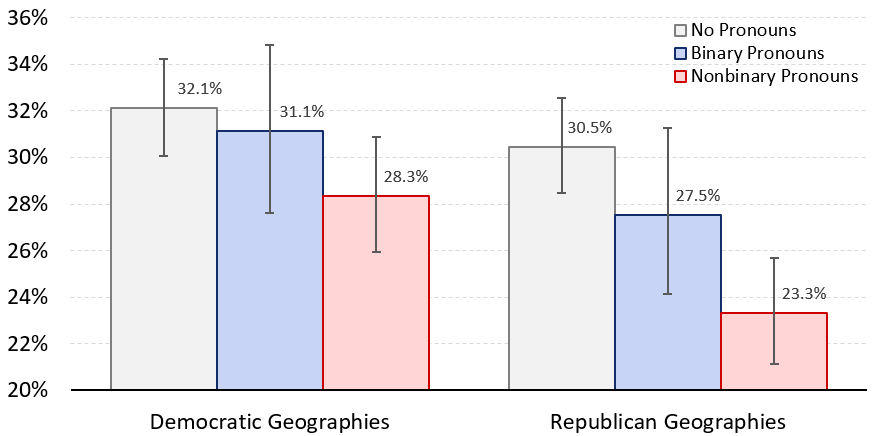
Should preferred pronouns be disclosed on resumes? For non-binary people looking for a job, that decision should consider the now-quantifiable likelihood of discrimination by potential employers. Disclosing the use of nonbinary pronouns on resumes reduces positive employer response by 5.4 to 5.5 percentage points. The results come from a field experiment conducted by Taryn Eames, a PhD candidate at the Department of Economics, University of Toronto. It is the first large-scale study of its kind to examine pronoun disclosure and employer discrimination.
“Putting “they/them” pronouns on your resume will disadvantage applicants in terms of average employer response,” said Eames. “However, if it is important for applicants to work at a company that respects them and their identity, disclosing pronouns may be a useful filter to screen out discriminatory employers.”
Eames’ experiment took the form of a resume audit. She sent thousands of randomly generated fictitious resumes to job postings in pairs. The treatment resume contained pronouns listed below the name and the control resume did not. In the treatment resume, Eames tested both nonbinary “they/them” pronouns and binary “he/him” or “she/her” pronouns consistent with implied gender of the name used on the resume. Resumes disclosing the use of they/them were less likely to receive a positive employer response, such as an invitation to interview, a voice mail or an email requesting a call back, or other expressions of interest.
Politics were also evident in this form of discrimination. Applications were sent to employers located in six cities in three states, and each city was categorized as Democratic or Republican based on 2020 Presidential voting records. For example, in the neighbouring cities of Denver and Colorado Springs, Denver is considered Democratic and Colorado Springs Republican. Eames found discrimination against nonbinary applicants to be about double in Republican cities than in Democratic cities. The level of discrimination was estimated to be 3.5 to 3.6 percentage points in Democratic areas versus 7.3 to 7.5 percentage points in Republican areas.

While gender discrimination was also evident when the employers were looking to fill traditionally female or male-dominated jobs, the discrimination against nonbinary individuals applying to these jobs was compounded.
“Applicants with multiple minority identities are doubly disadvantaged,” Eames explained. “I find that when females apply to male-dominated occupations and disclose ‘they/them’ pronouns, positive employer response rates are 10.9 to 11.8 percentage points lower versus 5.4 to 5.5 percentage points lower in the general case. A similar trend is true when males apply in female-dominated occupations.”
If nonbinary job seekers are starting to doubt their own competency, Eames results suggest that they are probably not the problem.
“I think the main benefit of audit studies is that they confirm discrimination exists,” Eames said. “The nonbinary / transgender population is severely under-researched, in part due to lack of data,” Eames said. “Moving forward, I think more research needs to be done here. I am happy to see that the Canadian Census and U.S. Household Pulse Survey included gender identity questions for the first time in 2021. I would love for more surveys and other data sources to include this information, so researchers are able to conduct analysis.”
There are tools human resources professionals have access to that can help prevent this kind of hiring discrimination, but Eames cautions, the literature shows that these tools are not bandage solutions and must be used to serve each company’s strategy and goals.
“Blind hiring, or anonymizing applications, has been shown to advance DEI initiatives in general, especially when companies are trying to prevent negative discrimination,” Eames explained. “However, it can also prevent companies who are actively seeking to increase diversity and implement affirmative action-type policies from doing so. Whether this approach works is thus situational. If a company is struggling with diversity, it may be useful, but if a company is already prioritizing diversity, it may do more harm than good. Unconscious Bias (UB) training is another tool companies can use to reduce discrimination. However, traditional approaches often do not go far enough: they are voluntary and largely focus on explaining what unconscious bias is. In general, this kind of training has not been shown to change behaviour. More promising is UB training that is focused on developing strategies and tools to reduce bias, rather than simply acknowledge its existence.”
The working paper Taryn versus Taryn (she/her) versus Taryn (they/them): A Field Experiment on Pronoun Disclosure and Hiring Discrimination (January 14, 2024) is available at SSRN.
Return to the Department of Economics website.
Scroll more news.
